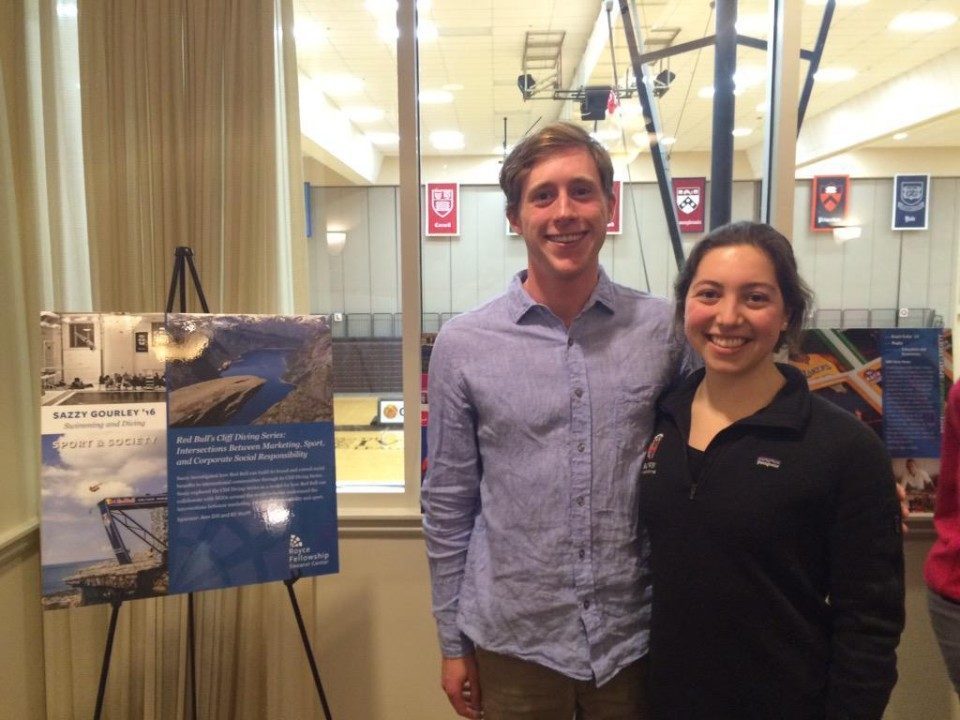Brown University’s Sazzy Gourley (diving) and Lauren Levy (swimming) are both recipients of the prestigious Royce Fellowship for Sport and Society, and by extension, have been admitted as members of the Society of Royce Fellows.
The Royce Fellowship Program was established by Charles Royce (of Royce Funds fame) in 1996. Royce, who graduated from Brown in 1961, funded the program to support Brown undergraduates doing independent research projects in a variety of disciplines. The Royce Sport and Society Fellowship was established in 2007 to support Brown student-athletes who embark on innovative research or applied projects, exploring the intersection of sport and human rights within a particular context.
Sazzy Gourley ’16
Candidate for Bachelor of Arts – American Studies
Gourley was awarded the Royce Fellowship in 2014 for his project investigating how Red Bull could build its brand and extend social benefits to international communities through its Cliff Diving World Series. He explored the Cliff Diving World Series as a model for integrating sport into the company’s framework for corporate social responsibility.
Amongst other things, Gourley concluded in his report that Red Bull’s participation in and marketing of the Cliff Diving World Series helped to legitimize the sport and gain media attention. This exposure led to FINA’s establishing High Diving as its 6th officially recognized aquatic sport. Gourley further noted that the series offers a platform to highlight female participation in extreme sports, and that for all athletes, participation in the Cliff Diving Series is the most effective way to gain access to the FINA High Diving World Championships.
Gourley offers a few suggestions as to how Red Bull could strengthen its relationships with local communities to foster a stronger sense of corporate responsibility, such as increasing recycling, respecting local traditions and working more closely with local organizations and government agencies.
Lauren Levy ‘16
Candidate for Bachelor of Science – Biochemistry & Molecular Biology
Two-Dimensional Geometric Control of Chondrogenic Differentiation for Cartilage Cellular Engineering
Levy received her fellowship a week ago as part of the 2015 cycle. She plans to investigate a new way to better grow human cartilage in the lab. She told SwimSwam:
In competitive athletics, two of the most common injuries are tears in cartilage–the rotator cuff (about the shoulder joint) and the meniscus in the knee. Cartilage functions as a soft tissue buffer between bones to reduce friction during movement. Excessive use over time (e.g. excessive training in athletics) and degenerative diseases, such as osteoarthritis, cause cartilage to deteriorate and/or tear. Unlike many cells in the body, cartilage cells, known as chondrocytes, cannot regenerate. Think about the skin: if you get a cut, you make new epithelial (skin) cells to heal the cut–your skin cells regenerate. With cartilage, however, it is “one and done.” The body doesn’t make new cartilage to replace damaged or lost cartilage cells.
Stem cell-based therapies have emerged as effective treatment options for a variety of medical issues requiring the regeneration of specific tissue. Stem cells are nonspecific cells, meaning that they aren’t a specific type of cell (like a bone cell, heart cell, cartilage cell, etc.) but they have the potential to transform (differentiate) into a specific cell type. Everyone has stem cells in their body; in particular, mesenchymal stem cells (MSCs) are found in bone marrow. Notably, MSCs can differentiate into cartilage cells (chondrogenic differentiation). For cell-based therapies, first, MSCs are harvested from the patient via a biopsy, then cultured (grown) in a cell culture flask in the lab. Various biochemical and physical cues, such as proteins and mechanical forces, are incorporated into the cell culture environment. The specific cell type that the stem cells turn into depends on the incorporated cues. Once the MSCs have fully become the desired cell type, doctors surgically implant the new cells into the patient at the damaged site. As the implanted healthy cells grow, the tissue is regenerated. Processes, such as cartilage degradation, are “reversed.”
However, when MSCs are grown into cartilage cells in the two-dimensional environment that is the bottom of a cell culture flask, the cartilage cells have a tendency to dedifferentiate–revert back to their nonspecific, stem-like state. This means that the cartilage cells grown in the lab don’t necessarily remain as cartilage cells, which is not good for use as a regenerative treatment. As a result, chondrocyte-based therapies aren’t in wide-spread clinical use. Advances in the culture of MSCs into cartilage cells in the lab can hopefully improve the efficacy of their culture such that chondrocyte-based therapies can be a more readily accessible treatment option in the near future. This is what I hope to contribute to with my project.
Many researchers have investigated the effect of different biochemical cues on the culture of MSCs into cartilage, but the effects of physical cues have only just begun to be explored. Recent research has indicated that physical geometric constraint on individual stem cells in two-dimensional culture strongly influences the transformation of those cells into fat cells and bone cells. My research project focuses on taking this one step further for cartilage cells, which has yet to be studied in the field. I am developing a novel cell culture environment that integrates biochemical and physical cues via geometric constraint on the transformation of MSCs into cartilage. I hypothesize that culturing the stem cells in a pattern that mimics the geometry of mature cartilage will prime the MSCs to become cartilage, and that this initial priming will result in cartilage that maintains its cartilage phenotype and doesn’t dedifferentiate. To test my hypothesis that spatial control will enhance the transformation of MSCs into cartilage, I am developing two-dimensional patterned surfaces on which to culture the cells. If my hypothesis proves correct (which I hope it will!), it will be a new way to grow cartilage more effectively in the lab and be a huge advancement for cartilage regenerative medicine.
